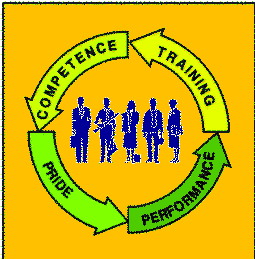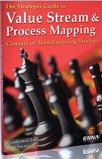|
 Training
for Lean Manufacturing teams should cover many areas.
Among these are Statistical Process Control, Root Cause Analysis, Team Building, and job skills.
As a result of training and application, teams and individuals are more competent. They work
better together in many ways. Training
for Lean Manufacturing teams should cover many areas.
Among these are Statistical Process Control, Root Cause Analysis, Team Building, and job skills.
As a result of training and application, teams and individuals are more competent. They work
better together in many ways.
-
Destructive, emotional conflict evolves to constructive discussion and rational problem
solving.
-
Decisions get made quickly and with consensus
-
Meetings become timely and produce results.
-
People help one another.
-
The work gets done.
Types of Training
Team Process Training
Team process refers to the activities and relationships within the team. It involves
communication, conflict resolution, time management and other activities. Team process also
refers to the gradual establishments of behavioral norms, team objectives and bonding.
Members do not possess instinctive knowledge of team processes and they are unlikely to learn
effective team processes from their cultural environment. Training can help and we recommend at
least a full day of training on team process.
Effective teamwork requires a set of specific skills and behaviors that are not inherent in
our culture. Communication is one example. Many potential team members are quite good at
talking. Few have effective listening skills. Conflict will arise whenever two or more people
interact. Teams need skills that resolve conflict and not just bury it or tolerate it. Teams
need to manage their own time and learn to hold effective meetings. Training can develop these
and other skills.
Task Training
When team members lack the skills to accomplish their tasks, the team experiences frustration
and conflict. Adequate task training can reduce this source of frustration in the critical early
days.
Teams often need considerable cross training. Cross training helps the team function if a
member is temporarily absent. It also gives each member a better appreciation for the
difficulties other members may face. In many workcells, cross training is essential for workers
to balance their workload.
|
Coaching
Training is not enough, however. Most team members have difficulty when they first attempt to
apply the principles they learn in the classroom. Coaching bridges this gap. An effective coach
helps the team to see where principles and techniques can apply. Much of the learning of team
process can only be gained through experience. An effective coach can guide the team through
their early experiences and accelerate this learning.
The Virtuous Circle of Team Learning
 We all know about "Vicious Circles". Teams are in a "Virtuous Circle" in which actions
trigger effects in a cycle that returns to and reinforces the original action. We can trace a
virtuous or vicious circle from anywhere on the loop. Let us arbitrarily start at "Training." We all know about "Vicious Circles". Teams are in a "Virtuous Circle" in which actions
trigger effects in a cycle that returns to and reinforces the original action. We can trace a
virtuous or vicious circle from anywhere on the loop. Let us arbitrarily start at "Training."
Competence engenders pride for both teams and individuals: Pride in their work, skills, and
accomplishments. Pride and competence bring high performance: the "Can Do" and "Will Do".
High performance leads to more training as management sees the benefits. Teams work
within their groups to cross-train and assist one another. This renewed training results in
higher competence and the Virtuous circle repeats and reinforces.
This virtuous circle is a powerful motivator. It is, for
example, the thing that keeps military units together in the worst of battle. Perceptive managers recognize and utilize this effect as part of their Lean Manufacturing
Strategy.

|





